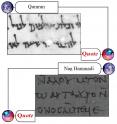Dead Sea Scrolls & Nag Hammadi Codices online
[ by Charles Cameron — archaeology, Biblical scholarship, eschatology, digital literacy ]
.
Both the Dead Sea scrolls from Qumran and the Gnostic and associated codices from Nag Hammadi are now available for study online:
The Nag Hammadi Archive can be explored via the Claremont Colleges Digital Library, and the Digital Dead Sea Scrolls via the Israel Museum, Jerusalem.
Here’s a description of the War Scroll from Qumran, which “is dated to the late first century BCE or early first century CE”:
Against the backdrop of a long biblical tradition concerning a final war at the End of Days (Ezekiel 38-39; Daniel 7-12), this scroll describes a seven stage, dualistic confrontation between the “Sons of Light” (the term used by Community members to refer to themselves), under the leadership of the “Prince of Light” (also called Michael, the Archangel) – and the “Sons of Darkness” (a nickname for the enemies of the Community, Jews and non-Jews alike), aided by a nation called the Kittim (Romans?), headed by Belial. The confrontation would last 49 years, terminating in the victory of the “Sons of Light” and the restoration of the Temple service and sacrifices. The War Scroll describes battle arrays, weaponry, the ages of the participants, and military maneuvers, recalling Hellenistic and Roman military manuals.
You can see why I’m interested.
The Nag Hammadi texts are a little less well known but include — along with a variety of other texts, some of them self-described as “apocalypses” — the now celebrated Gospel of Thomas, which Bart Erhman reads as continuing a “de-apocalypticizing” of Jesus’ message which he finds beginning in Luke and continuing in John:
In the Gospel of Thomas, for example, written somewhat later than John, there is a clear attack on anyone who believes in a future Kingdom here on earth. In some sayings, for example, Jesus denies that the Kingdom involves an actual place but “is within you and outside you” (saying 3); he castigates the disciples for being concerned about the end (saying 18); and he spurns their question about when the Kingdom will come, since “the Kingdom of the Father is spread out on the earth and people do not see it” (saying 113).
Again, you can see why I am delighted that these texts are becoming available to a wider scholarly audience…
In both the Nag Hammadi codices and Qumran scrolls, we have texts that were lost for almost two thousand years and discovered, somewhat haphazardly, in 1945 and 1947 respectively, providing us with rich insights into the religious ferment around a time and place that have been pivotal for western civilization.
Now, more than half a century later, the web — as it becomes our global museum and our in-house library — brings us closer to both…

Dave Schuler:
September 28th, 2011 at 2:06 pm
This is the next step in what is an amusing story and, more importantly, a cautionary tale about the Qumran scrolls. As far as, I think, as 1949 a photographic copy of the scrolls were made, copies of which were sent to the Huntington Library in California in case the originals were destroyed with the proviso that they not be published. After nearly a half century of failure to publish by the (I think) French Jesuits who were entrusted with the study and publication of the scrolls, the Huntington went ahead and published them itself in 1991. As it turned out the scholars who were dragging their heels were doing so because without exclusive control they feared they’d be out of a job. This web publication is the next step in that journey.
Charles Cameron:
September 28th, 2011 at 5:24 pm
Hi Dave:
.
I get the impression that Cindy Alberts Carson‘s Raiders of the lost scrolls: the right of scholarly access to the content of historic documents (16 Mich. J. Int’l L. 299) would be good to read, but lack access, alas! — my own recollection is that the Dominican, Roland de Vaux, was the person who set up the multi-national and multi-confessional team and instituted the regime of tight control at the Ecole Biblique in Jerusalem, and that Israeli proprietary interest in the physical scrolls played a role, too.
.
One interesting factoid from the fascinating timeline on the history of the scrolls that can be found at the Gnostic Society library site, is that the Society for Biblical Literature passed a resolution in 1991 "affirming the right of all scholars to have access to facsimile reproductions of all ancient manuscripts without any publication restriction".
.
I’m thinking this kerfuffle looks to have been an important precursor of the "information wants to be free" / open scholarship debate.